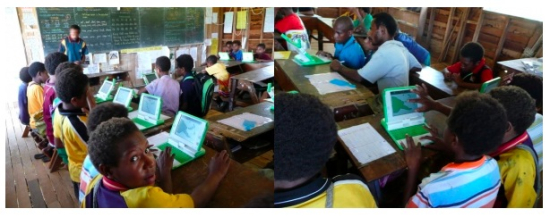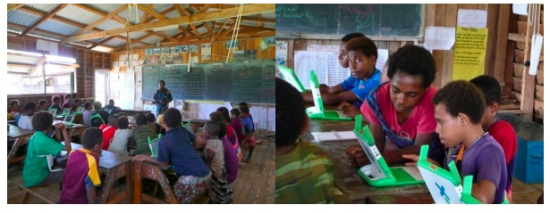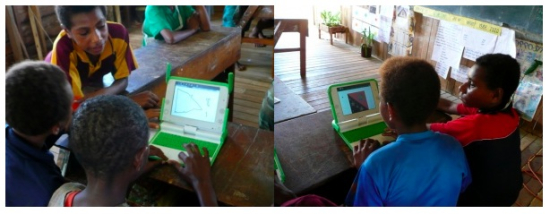
"For a truly inclusive learning environment to be established in a school classroom, every child and the teacher must have a laptop. If only some have laptops, it creates a divide with negative impacts such as a demoralizing effect on those children and teachers that do not have them, and hinders community-building." From One Laptop per Pacific Child: creating OLPC Oceania
"Saturation: As with vaccinations, digital saturation implies a commitment to maintaining these tools as part of primary education over time... without a digital divide." From OLPC's Five Founding Principles
When I talked with the teachers at Rumginae Primary School in Papua New Guinea, they were really struggling with this issue. Although all of the teachers had received laptops and a (two-day) training on them, only the 3rd and 4th grade class students (out of 3rd-8th grades at the school) were given laptops.
To deploy or not to deploy if you know you can't saturate?
If you KNOW you're going to be creating a digital divide, where do you draw that line? Or should that line be drawn?
The teachers from Rumginae clearly identified the demoralizing effect that an incomplete deployment had on their staff and on their students. There was no clear plan for when or whether the school would be receiving additional laptops, and this was the FIRST question the school's headmaster wanted to talk about with the person who brought me to their school.
There were a number of other issues the teachers discussed with me in Rumginae, and I'll return to them in the next post. This one had them rather evenly divided--with about half of the teachers arguing that it would've been better not to have deployed at all, and about half arguing that they're happy the laptops came to their school (although the former was argued more passionately).
At the Jim Taylor school in Kisap (the school I had previously visited), this question has (to date) been avoided, because the teachers have been told (promised?) that saturation-level laptops will be arriving in a few months, thus blanketing the second half of the school. They were reassured that everyone would be able to participate in a few short months.

But what happens if they don't receive their laptops?
This same question, applied on a larger scale, led to the following questions: Is it better to deploy at just a very few pilot schools, but achieve saturation at those schools, keeping in mind that the situations at these specific schools may be quite particular (keeping in mind that human beings have chosen which schools would be included in the pilot project and that these were usually chosen for particular reasons--sometimes because of existing infrastructural capacity, sometimes for political reasons, the list of possibilities goes on and on...)
Or, is it better to spread out the pilot deployment to a number of schools, which not only spreads awareness of the project across a wider audience across the country and possibly allows more schools to be set up with the infrastructural necessities (electricity, connectivity) and provides more teachers with training? PNG--so far--has opted for the second approach.
In other words, do we aim for perfection at a few pilots, which may not be replicable elsewhere? Or do we try to achieve maximum reach and spread, knowing that we may be creating even more divides? Or, that spreading ourselves too thin (two-day training sessions??) may mean multiple failed pilots, instead of a few successful ones?
I don't have answers to these questions, and certainly I'm not the first person to bring up or grapple with this issue--it's one of the larger quandaries facing the OLPC program in general. However, I've been thinking about it from an academic point of view--"in theory". Now I got to see, talk to, and hear about it from people dealing with the ramifications of this dilemma on a daily basis. There were strong feelings, passionately argued.

These laptops are a BIG DEAL, and it's far from ok to go about making decisions about them lightly, or based upon theory or logic or reasoning achieved from the comfort of one's academic office--decisions regarding choices that will of necessity violate the core principles of the program, by the way, but I'm seeing violations of the core principles in nearly every deployment--because the complete technological ecosystem in which the project was dreamed up, is far from a reality in most all of the places the OLPC project is being tried out.
When you can't create this entire ecosystem, because of infrastructural, budgetary, and political constraints (among others), what gives? Where do you skimp? Which core principles are the least important--and therefore the least egregious to violate? You can read more reactions to this quandary at Rumginae: Multiple Dilemmas (Part I).
The pictures posted were meant to convey more images of the students productively using the laptops, but in fact, a number of them capture how it must be less than thrilling or inspiring to only be able to watch as your classmate "joyfully self-empowers"


The problem does not stop at the primary school level when these students graduate and go on to the secondary school. Secondary schools are usually made up by many different schools joining together. At this point, the problem of some students having computers and training becomes even more evident. There are no easy answers.